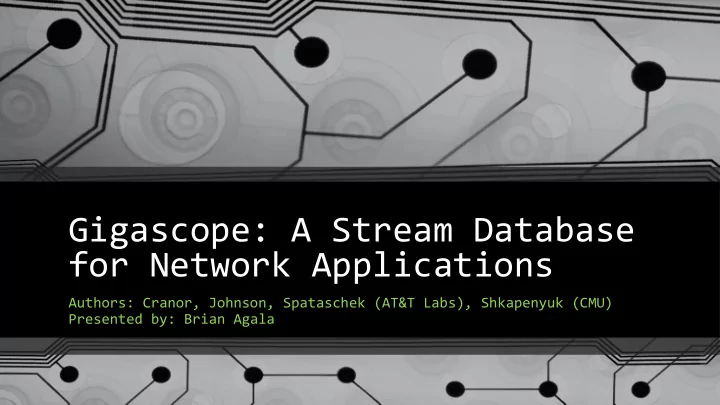

Gigascope: A Stream Database for Network Applications Authors: Cranor, Johnson, Spataschek (AT&T Labs), Shkapenyuk (CMU) Presented by: Brian Agala
Overview • Problem • Goals • Background: Data Streams • Gigascope Data Stream Management System • Conclusions Brian Agala 10/28/2014 2
Problem: Managing a Large Data Communications Network • Requires constant network monitoring • Decentralized Difficult to manage • Analyze network trace dumps • Limited set of network monitoring reports Brian Agala 10/28/2014 3
Goals Develop a network data analysis tool which has: • Speed and flexibility that network analysts require • Provides structured querying environment to make complex analysis easy to control Brian Agala 10/28/2014 4
Goals Create a data analysis engine that will be used in many settings: • traffic analysis • performance monitoring • debugging • protocol analysis and development • router configuration • intrusion detection • network monitoring Brian Agala 10/28/2014 5
Data Streams: Why Now? • Haven’t data feeds into databases always existed? Yes • Modify underlying databases and data warehouses • Complex queries are specified over stored data DB Queries • With traditional data feeds • Simple queries needed in real-time • Complex queries performed offline Brian Agala 10/28/2014 6
Data Streams: Real-Time Queries, High-Volume and High-Velocity Data • Two recent developments: application and technology driven • Need for sophisticated real-time queries/analyses • Massive data volumes of transactions and measurements DB … with the need for Massive volumes of data real-time queries … arriving at high-velocity Queries Brian Agala 10/28/2014 7
Databases vs Data Streams Database Systems Data Stream Systems • Relation: tuple set • Relation: tuple sequence • Data Update: modifications • Data Update: appends • Query: transient • Query: persistent • Query Answer: exact • Query Answer: approximate • Query Evaluation: arbitrary • Query Evaluation: one pass Brian Agala 10/28/2014 8
Gigascope: Data Stream Management System (DSMS) for Network Applications • Designed for monitoring high-rate data streams • Pure stream database (no stored relations or continuous queries) • Pipelined operators that rely on properties of the stream • Uses SQL-like language, named GSQL • Input is a data stream, output is a data stream • Simplicity of implementation, does not transform input data stream into a windowed table, operate on data stream directly Brian Agala 10/28/2014 9
The Language • Supports selection, join, aggregation, and stream merge • GSQL processor is a code generator, translating the query to C or C++ code resulting in a fast execution system • Example 1: Get destination IP, port, and timestamp from TCP packet on the first Ethernet interface card DEFINE { query_name tcpDest0; } Select destIP, destPort, time From eth0.TCP Where IPVersion = 4 and Protocol = 6 • Example 2: Combine streams from multiple sources into a single stream DEFINE { query_name tcpDest; } Merge tcpDest0.time : tcpDest1.time From tcpDest0, tcpDest1 Brian Agala 10/28/2014 10
Gigascope Architecture • Two layer architecture for early data App reduction high high • High level queries for expensive processing (High-level Filtering, low low low Transformation, and Aggregation – HFTA) Ring buffer • Fast lightweight data reduction queries (Low-level Filtering, Transformation, and NIC Aggregation – LFTA) • Possible to push the query as far down as the NIC as an optimization Brian Agala 10/28/2014 11
Gigascope: Hidden P2P Traffic Detection • Business Challenge: AT&T IP customer wanted to accurately monitor peer- to-peer (P2P) traffic within their network • Previous Approach: Using TCP port number found in Netflow data • Issues: P2P traffic might not use known P2P port numbers • Solution: • Use Gigascope to search for P2P related keywords within each TCP datagram • Identified 3 times more P2P traffic than when using Netflow Brian Agala 10/28/2014 12
Gigascope: Web Client Performance Monitoring • Business Challenge: AT&T IP customer wanted to monitor latency observed by clients to find performance problems • Previous Approach: Measure latency from “active clients” that establish network connections with servers • Issues: Use of “active clients” is not very representative • Solution: • Use Gigascope to track TCP synchronization and acknowledgement packets • Report round trip time statistics: latency Brian Agala 10/28/2014 13
Gigascope: Other Applications Desired goals for Gigascope: • traffic analysis (E.g. Hidden P2P Traffic Detection) • performance monitoring (E.g. Web Client Performance Monitoring) • debugging • protocol analysis and development • router configuration • intrusion detection • network monitoring Brian Agala 10/28/2014 14
Conclusions • Querying and finding patterns in massive streams is a real problem with many real-world applications • Need for sophisticated real-time queries • Massive data volumes of transactions • Fundamentally rethink data management issues under stringent constraints: • Single-pass algorithms with limited memory resources • Resource limitations at low-level • Important to think of end-to-end architecture Brian Agala 10/28/2014 15
Recommend
More recommend